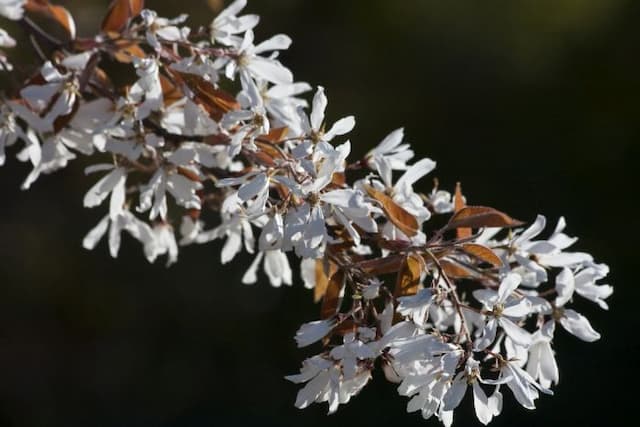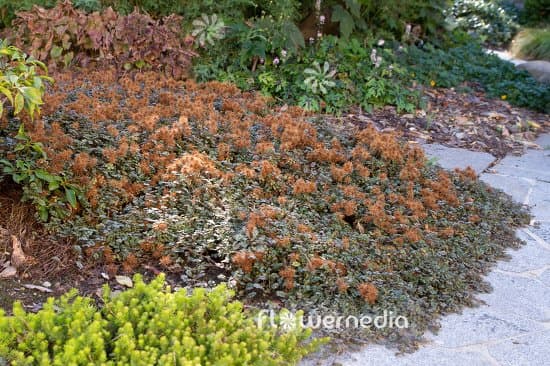Japanese kerria Kerria japonica 'Golden Guinea'

ABOUT
Kerria japonica 'Golden Guinea', commonly known as Japanese kerria or Easter rose, is a deciduous shrub recognized for its striking flowers and bright green stems. This cultivar is particularly noteworthy for its large, golden-yellow blooms, which are typically more substantial than those of the species. The flowers are single, with a rosette of petals surrounding a prominent central cluster of bright yellow stamens. These cheerful blossoms stand out against the plant's bright green stems, which maintain their color throughout the year and add winter interest even after the leaves have fallen. The foliage consists of toothed, bright green leaves that are somewhat lance-shaped and provide a lush background throughout the growing season. In autumn, the leaves may turn a clear yellow, contributing to the plant's fall display before they drop. The Japanese kerria presents a rounded, arching growth habit, with branches that can appear somewhat twiggy and delicate.
About this plant
 Names
NamesFamily
Rosaceae.
Synonyms
Japanese Kerria, Japanese Rose, Easter Rose, Yellow Rose of Texas.
Common names
Kerria japonica 'Golden Guinea'.
 Toxicity
ToxicityTo humans
The Japanese Kerria is not known to be toxic to humans. There is no typical symptom of poisoning because it is generally considered a non-poisonous plant. Therefore, ingesting parts of the Japanese Kerria is not expected to cause any harmful consequences to human health.
To pets
The Japanese Kerria is not known for being toxic to pets either. Similar to its effects on humans, ingestion of this plant should not cause any serious issues in pets as it is generally regarded as non-toxic. No symptoms of poisoning from the Japanese Kerria are expected in pets.
 Characteristics
CharacteristicsLife cycle
Perennials
Foliage type
Deciduous
Color of leaves
Green
Flower color
Yellow
Height
5-6 feet (1.5-1.8 meters)
Spread
6-8 feet (1.8-2.4 meters)
Plant type
Shrub
Hardiness zones
4-9
Native area
China, Japan
Benefits
 General Benefits
General Benefits- Aesthetic Appeal: Bright yellow flowers create a stunning visual display in gardens during spring.
- Low Maintenance: Kerria japonica 'Golden Guinea' is known for being easy to care for, requiring minimal attention once established.
- Drought Tolerance: This plant can withstand periods of dryness, making it suitable for gardens in regions with less rainfall.
- Shade Tolerance: Able to thrive in partial shade, it can be planted in various garden spots that receive limited sunlight.
- Cold Hardy: It's resilient in cold climates, surviving in USDA zones 4 through 9.
- Wildlife Friendly: The flowers attract pollinators such as bees, which are beneficial for the garden ecosystem.
- Erosion Control: Its root system helps stabilize soil, preventing erosion in sloped garden areas.
- Flexible Landscaping: Works well as a border plant, in foundation plantings, or as part of a shrubby garden backdrop.
- Fast Growing: Quick to establish and spread, it helps in swift coverage of garden areas.
- Year-Round Interest: With bright stems and a structured form, it offers visual interest even outside blooming seasons.
 Medical Properties
Medical PropertiesThis plant is not used for medical purposes.
 Air-purifying Qualities
Air-purifying QualitiesThis plant is not specifically known for air purifying qualities.
 Other Uses
Other Uses- Kerria japonica 'Golden Guinea' branches can be used in floral arrangements for their bright green, arching stems, even when not in bloom.
- The peeling bark of older stems provides textural interest in winter gardens when the landscape has fewer focal points.
- In craft applications, the flexible stems of the plant can be woven into baskets or used in the creation of plant-based art pieces.
- Due to its dense growth habit, Kerria japonica 'Golden Guinea' can be pruned into low informal hedges or borders in a garden setting.
- The plant's vigorous growth ability allows it to be used in erosion control on sloped areas of a landscape.
- The flowers of the Kerria can be used to create natural dyes, offering a range of soft yellow hues for fabrics and paper.
- Kerria japonica 'Golden Guinea' is planted as a living screen for privacy in gardens due to its dense foliage.
- The plant can act as a host for butterfly larvae, playing a role in supporting the local ecosystem.
- Its considerable resistance to pollution makes it suitable for urban and roadside planting, contributing to urban green spaces.
- Photographers and painters may use Kerria as a subject for its vibrant yellow flowers and picturesque growth habit, providing aesthetic inspiration for their art.
Interesting Facts
 Feng Shui
Feng ShuiThe Japanese Rose is not used in Feng Shui practice.
 Zodiac Sign Compitability
Zodiac Sign CompitabilityThe Japanese Rose is not used in astrology practice.
 Plant Symbolism
Plant Symbolism- Renewal: Kerria japonica 'Golden Guinea' blooms in early spring, symbolizing nature's cycle of rebirth and new beginnings.
- Cheerfulness: The bright yellow flowers of the Japanese Kerria are often associated with joy and happiness due to their sunny color.
- Adaptability: As it can grow in a variety of soil conditions and can tolerate some shade, this plant represents versatility and resilience.
- Perseverance: This hardy shrub has a vigorous growth habit and can bounce back from pruning or damage, a trait that symbolizes endurance and persistence.
 Water
WaterFor 'Golden Guinea' Kerria, water deeply once a week to keep the soil consistently moist but not waterlogged. During hot, dry periods, increase watering frequency to twice a week. Provide about 1 to 1.5 gallons of water for each watering session to ensure the root zone is well hydrated. During the winter months, reduce watering as the plant's water requirements decrease. Ensure the plant is in well-draining soil to prevent root rot from excessive moisture.
 Light
Light'Golden Guinea' Kerria thrives in full sun to part shade. The ideal location provides morning sunlight with some afternoon shade, or dappled sunlight throughout the day. Avoid deep shade as it can result in fewer flowers and a less dense plant. The bright indirect light will encourage profuse flowering in the springtime.
 Temperature
Temperature'Golden Guinea' Kerria is hardy and can tolerate a range of temperatures. It can survive minimum temperatures down to about 0 degrees Fahrenheit and is suitable for USDA hardiness zones 4 through 9. The ideal growing temperature for 'Golden Guinea' Kerria is between 60 and 75 degrees Fahrenheit. Extreme heat over 90 degrees Fahrenheit may stress the plant, so providing some afternoon shade in hotter regions can be beneficial.
 Pruning
PruningPrune 'Golden Guinea' Kerria shortly after it finishes flowering in late spring or early summer to shape the shrub and remove any dead or overcrowded stems. This will also encourage new growth which can result in more flowers the following season. Pruning is recommended annually to maintain the health and appearance of the plant. The best time for major pruning is immediately after the plant has flowered to ensure blooming is not affected for the next year.
 Cleaning
CleaningAs needed
 Soil
SoilGolden Guinea Kerria prefers well-drained, loamy soil with a pH range of 6.0 to 7.5. A mixture of garden soil, compost, and peat moss can provide an ideal growing medium, ensuring sufficient nutrients and moisture retention for optimal growth.
 Repotting
RepottingGolden Guinea Kerria, when grown in containers, should be repotted every 2-3 years, or when it becomes root-bound. This helps ensure it has enough space to grow and receives fresh nutrients from new soil.
 Humidity & Misting
Humidity & MistingGolden Guinea Kerria thrives in a range of humidity conditions and does well in the average humidity found in most outdoor garden environments without needing any special requirements.
 Suitable locations
Suitable locationsIndoor
Place near bright, indirect light and maintain moist soil.
Outdoor
Plant in part shade or full sun, with well-draining soil.
Hardiness zone
4-9 USDA
 Life cycle
Life cycleThe life cycle of Kerria japonica 'Golden Guinea', commonly known as Golden Guinea Japanese Rose, begins with seed germination, where the plant emerges from its dormant state in suitable moist and shaded soil conditions. The seedling stage follows, characterized by the development of primary leaves and the establishment of a root system, during which the plant is particularly delicate and requires consistent moisture and protection from harsh sunlight. As it enters the vegetative growth stage, the plant develops a more robust stem, additional leaves, and begins to form the characteristic bright green, arching branches for which it is known. During spring of the following years, it reaches the flowering stage, producing plentiful bright yellow, rose-like flowers that attract pollinators and bring aesthetic value to gardens. After pollination, seed formation takes place, and once mature, the seeds are dispersed to give rise to new plants, thereby continuing the life cycle. Lastly, in the phase of maturity and decline, which may take many years, the plant's growth slows, and it may show signs of reduced vigor, at which point propagation by division can rejuvenate the plant and start the cycle anew.
 Propogation
PropogationPropogation time
Spring-Early Summer
Propogation: The Kerria japonica 'Golden Guinea', commonly known as the Japanese kerria, is best propagated by softwood cuttings in the late spring to early summer. Cuttings should be taken from new growth that is just beginning to harden but is still flexible, about 4 to 6 inches long. To maximize success, dip the cut end of the cuttings into a rooting hormone powder to encourage root development. Afterward, the cuttings should be inserted into a well-draining potting mix and kept evenly moist in a warm, indirect light environment until roots have developed, which usually takes several weeks. Covering the cuttings with a plastic bag can help maintain humidity levels conducive to rooting. Once the cuttings have developed a robust root system, they can be transferred to individual pots and then eventually out into the garden.








![Tree amelanchier [Tradition]](/_next/image?url=https%3A%2F%2Fplants-admin.emdemapps.com%2Fimages%2Fplants%2F%2Fimages%2F604b56afa99a2.png&w=640&q=75)
